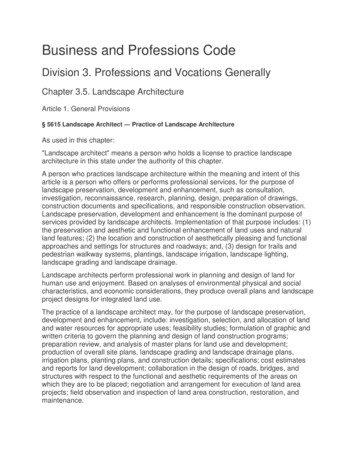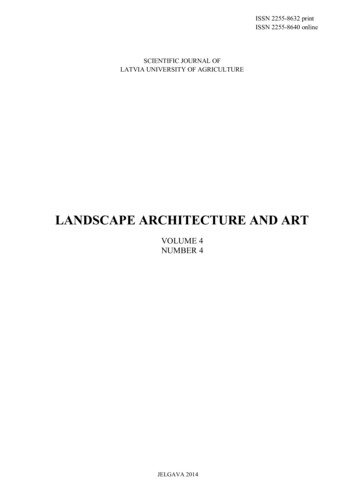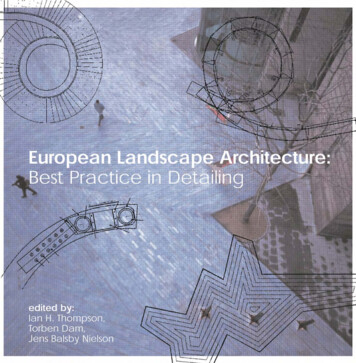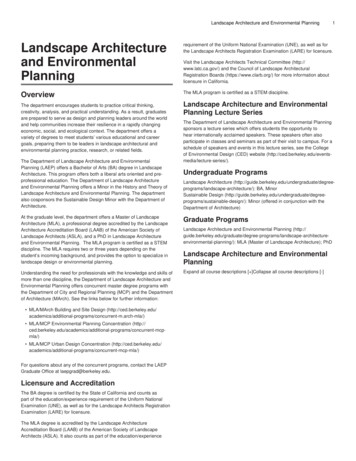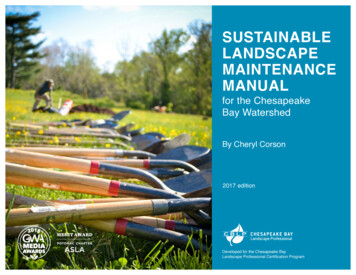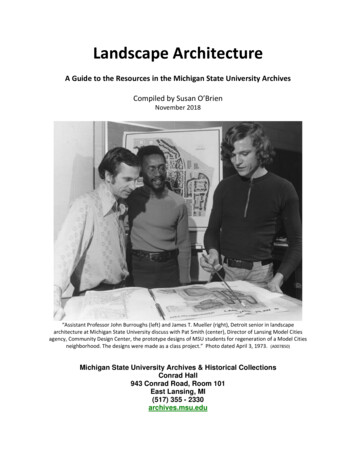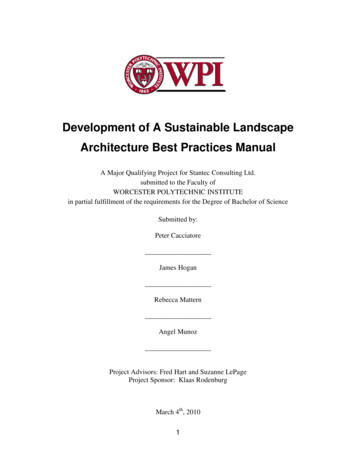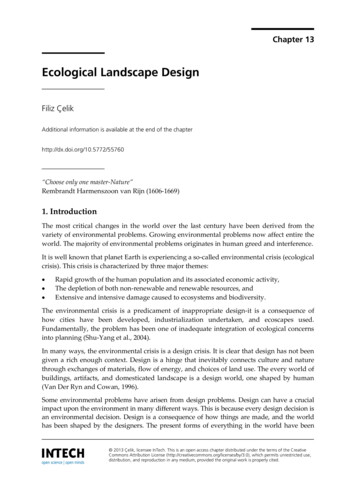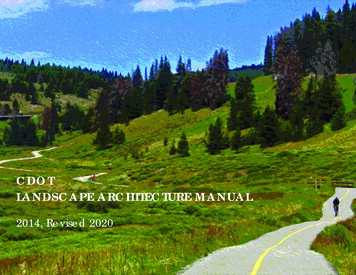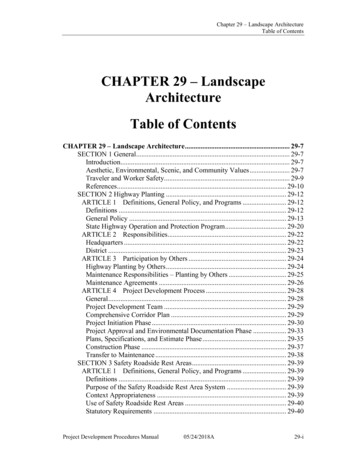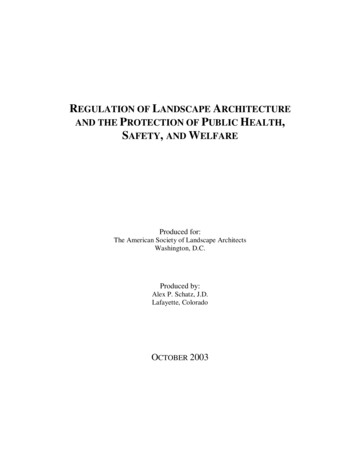
Transcription
REGULATION OF LANDSCAPE ARCHITECTUREAND THE PROTECTION OF PUBLIC HEALTH,SAFETY, AND WELFAREProduced for:The American Society of Landscape ArchitectsWashington, D.C.Produced by:Alex P. Schatz, J.D.Lafayette, ColoradoOCTOBER 2003
TABLE OF CONTENTSExecutive Summary . 4Introduction . 6Scope of Research . 8Regulation of the Design Professions . 9A Survey of Landscape Architecture Regulation .10Concurrent Jurisdiction: Architects and Engineers .12Evidence of Harm .16Physical Injury.17Lighting. 17Lighting Equipment.17Lighting Design.18Playgrounds. 19Plant Material . 21Site Planning . 23Parking Lots . 25Streetscape . 26Exterior Structures. 28Stairways .28Guardrails .29Walls .29Decks and Shade Structures.30Ramps.30Grading, Drainage, and Erosion Control . 31Grading.31Surface Drainage.32Storm Sewer Details.33Erosion Control .34Recreational Facilities. 34Active Recreation.34Golf Courses .35Trail Design .35Bodies of Water .37Roadway Improvements and Traffic Handling . 37Site Investigation . 39Other Landscape Architecture Design Hazards. 39Irrigation .39Landscape Edging .40Tree Staking.40Gates and Fencing .40Signage .41Property Damage.42Grading, Drainage, and Erosion Control . 42Regulation of Landscape Architecture and the Protectionof Public Health, Safety, and WelfarePage 2
Irrigation . 44Exterior Structures. 45Other Damage to Property . 46Site Planning.46Paved Surfaces .46Site Investigation.46Financial Harm .48Bidding Errors. 48Feasibility and Permitting Errors. 48Negligent Design . 50Loss of Consumer Choice . 51Additional Evidence Relating To Regulation .55Removing Barriers to Competition: Placing Landscape Architects on Equal Footing. 55Equal Footing: Statutes of Repose.55Equal Footing: Certificates of Review.56Equal Footing: Mechanics Liens.57Regulation in the Public Interest . 57Evaluation of the Need for Regulation.61Sunrise and Sunset Reviews of Landscape Architecture.63Application of the Evidence of Harm.66Does landscape architecture regulation address an easily recognizable potential for harm? . 66Does landscape architecture regulation promote the public interest?. 68Can landscape architecture regulation be accomplished without undue cost or impact toother professions? . 69A Need to Regulate: Findings and Responses .70Analysis of Forms of Regulation .71Deregulation .73Civil Litigation.75Consumer Protection Laws . 76Negligence and Professional Negligence Actions . 77Sovereign Immunity.78Expert Testimony and the Standard of Care .78The Economic Loss Rule .79Negligence Principles: General Remarks.81Private Boards .82Bonding .84Registration and Certification .85Licensing .87Conclusion .89Regulation of Landscape Architecture and the Protectionof Public Health, Safety, and WelfarePage 3
EXECUTIVE SUMMARYNumerous past reviews have found landscape architecture regulation necessary to protectpublic safety and prevent irreparable harm. Other reviews of the profession havehighlighted the need for a comprehensive presentation of the evidence related to thepotential for harm in landscape architecture practice.To address the need for regulation as a measure to protect public health, safety, and welfare,this report focuses on a pattern of legal harm not comprehensively documented in previousstudies of landscape architecture. These findings provide empirical evidence of harm causedby incompetent landscape architectural work, from the nuisance of repeated minor injuriesto permanent injury and death.This report specifically focuses on many representative incidents of injury that could havebeen prevented through competent landscape architectural practice. Because the approachtaken is empirical, presenting dozens of actual cases in many areas of landscape architecturepractice to establish the reality of the potential for harm, this report does not rely on anextensive description of the scope of landscape architecture to imply that there is a potentialfor harm. Where past discussions of the potential for harm may have required a technicalunderstanding of the profession, this report provides concrete evidence that defective designand inadequate supervision of landscape architectural work has the potential to cause, and,in fact, has caused, serious, irreparable harm.A number of professions are substantially and directly responsible for the orderlydevelopment of society’s physical, legal, and financial infrastructure. Regulation oflandscape architects and other design professionals is a valid step taken by states to fosterminimally competent, safe planning of the built environment. In these professions, certaineconomic influences must be subordinate to basic standards for public health, safety, andwelfare.Landscape architects are responsible for decisions that affect the condition of vitalinfrastructure, rights-of-way, and significant private and public site development. Whenperformed by negligent, incompetent, or unethical practitioners, landscape architecture hasthe potential to cause serious personal injuries. Poor landscape architecture practices canseriously impair the value and use of property. Landscape architects document andsupervise the construction of hundreds of millions of dollars in infrastructure and siteimprovements each year, where the potential to produce financial harm is also significant.This report includes examples of physical injury, property damage, and financial harm fromacross the spectrum of landscape architecture practice. Physical injuries, for example, haveresulted from poor design of outdoor lighting, playgrounds, plantings, parking lots,streetscape, outdoor stairs, decks, walls, earthwork, drainage features, recreational facilities,Regulation of Landscape Architecture and the Protectionof Public Health, Safety, and WelfarePage 4
fencing, and many other aspects of landscape architectural design. Many injuriesencountered in the research for this report are examples of irreparable harm caused byincompetent practice of landscape architecture, including fatal and permanently disablinghazards in designs and specifications. Competent landscape architects are able to apply avariety of techniques to mitigate the potential for harm in each of these situations.In a market with no state credential for landscape architecture services, non-practitionerclients have no reliable source of information addressing practitioner knowledge of healthand safety issues, regulatory compliance, avoidance of property damage, and other skillsgenerally expected of a design professional. The very nature of a technical professionmakes it impracticable for consumers who need these services to accurately assess therelative competence of an individual or firm. Professional regulation is needed to establish acomprehensive, enforceable set of practice standards and to prevent negligence andincompetence. Other methods of consumer and public protection are potentially unavailingfor injured victims and no deterrent for negligent design professionals.Without regulatory standards, where consumers cannot rely on a professional to producedesign and technical documentation that meets minimum standards of competence,bargaining is risky, and various legal doctrines may deflect legal responsibility where acompetent design professional should have identified techniques to mitigate physicalhazards and other project liabilities. State certification of landscape architects allowsconsumers to mitigate some amount of harm, particularly in the interest of reducingexposure for premises liability from hazardous and defective design. State licensing statuteshave developed with the specific intent of preventing malpractice, offering protection for notonly consumers of landscape architecture services but also the general public that frequentlyuses the built works of landscape architecture.Landscape architecture is one of the forty most commonly regulated professions, with over95 percent of the United States population living in a jurisdiction with state regulation of theprofession. Statutes regulating architecture, landscape architecture, and engineeringcollectively enhance the safety of the built environment as a place for people to live, work,and move about. Landscape architecture is a distinct, mature member of the designprofessions and its regulation is an essential component of statutory schemes to protectpublic health, safety, and welfare.Regulation of Landscape Architecture and the Protectionof Public Health, Safety, and WelfarePage 5
INTRODUCTIONThe profession of landscape architecture shares with the other design professions ofarchitecture and engineering a significant impact on public health, safety, and welfare. Inprojects designed for both public and private clients, architecture, landscape architecture,and engineering involve large construction investments and heavy use by the public.Landscape architects play a lead role in large public and private projects; they make criticalrecommendations and decisions affecting the sufficiency of these projects to meet publichealth and safety standards. For example, poorly specified paving surfaces and pedestrianamenities can expose public and private property owners to litigation and civil liabilityclaims when injuries occur, and documented cases of injury and property damage have beenlinked to design flaws in a variety of landscape architectural plans.Public health, safety, and welfare require the direct involvement of landscape architects inregulatory programs. Routinely, landscape architects both generate and check plans thatcontrol pedestrian, bicycle, and vehicular traffic; stabilize disturbed ground; avoid wastefulapplications of water in the landscape; discourage criminal activity; preserve land values;provide accessibility as required by law; specify playground equipment; and create safeplaces for recreation, civic events, transportation, offices, houses, and other public andprivate needs.Landscape architects and other design professionals are subject to professional regulationdue to substantial risks of physical injury, harm to property, and potential for significanteconomic damage. One court characterized landscape architecture as “a professionembracing a field of highly technical and specialized knowledge and activities between theprofessions of architecture and engineering.”1 As this report will show, regulation oflandscape architecture is warranted to reduce risks to a wide range of legitimate publichealth, safety, and welfare interests.Evidence presented in the past supporting architecture, landscape architecture, andengineering regulation has been found lacking by some regulatory authorities because of theperceived lack of evidence linking competence with state licensure requirements.2 It is12Matter of Geiffert v. Mealey, 59 N.E.2d 415 (N.Y. App. 1941); Paterson v. University of State of New York, 252N.Y.S.2d 452, 454-55 (N.Y. App. 1964) (“The practice of landscape architecture is recognized as the practice of aprofession in this state and elsewhere as a profession embracing a field of highly technical and specialized knowledgeand activities ‘between the professions of architecture and engineering’. Such a determination is in line with thenecessity for recognizing in the law, as in our universities, new professions which have been called into being to take careof modern requirements of our expanding civilization.”).See, e.g., Colorado Department of Regulatory Agencies, Sunset Review of the Board of Architect Examiners, 1980, at 1(Examining the need for regulation in the first Sunset Review of the architecture statute in Colorado, the Department ofRegulatory Agencies noted, “[M]embers of the profession and board members believe that significant public harm couldoccur if buildings were improperly designed. Our review agrees with this position but suggests there is no clear evidencethat the existing licensing mechanism assures safe building design.”) (emphasis added).Regulation of Landscape Architecture and the Protectionof Public Health, Safety, and WelfarePage 6
necessary to consider the following factors relating to the burden of proof as it affects designprofessionals: Professional boards view their essential role as prevention of harm, and manyboards focus on testing candidates for entry into the profession and educatingmembers regarding professional standards.3 Architects, landscape architects, and engineers routinely testify as expert witnessesin design negligence cases, but typically agree not to publicly discuss each case. Especially in the vast majority of cases that settle, design negligence litigation isextremely difficult to research due to the lack of publication and specific subjectmatter indexing of trial court cases. Most members of the design professions do not possess specific knowledge oflegal research.In addition to these general considerations, the profession of landscape architecture lacks theimmediate recognition of the other design professions, and the evidence supportingregulation typically receives a level of scrutiny that these allied professions do notexperience in equivalent reviews. The merits of landscape architecture regulation can beoverwhelmed by an inaccurate and incomplete characterization of the profession and thepotential for harm in its practice.This report specifically focuses on a pattern of legal harm not comprehensively documentedin previous studies of landscape architecture regulation. All potential harms are a valid andimportant regulatory concern, but these findings provide empirical evidence of harm,particularly irreparable harm – permanent injury and death – caused by negligent landscapearchitectural work. This report serves to document actual harms in cases that werepreviously treated only hypothetically in support of landscape architecture.4This report is intended to review the evidence of harm related to landscape architecture andthe various methods of evaluating professional regulation as applied to landscapearchitecture. As a survey of considerations in the regulation of this profession, it is intendedfor use by legislators, regulators, and members of the profession.3See Colorado State Board of Examiners of Architects, Position Statement for the Joint Legislative Sunrise/Sunset ReviewCommittee, Sept. 14, 1987, at 4 (“The purposes of the architectural registration board are to ensure that only persons withat least a minimum level of competence are permitted to practice and that practicing architects act according toprofessional standards of conduct.”).4Compare Legislative Auditor of the State of Hawaii, Sunset Evaluation Report of Professional Engineers, Architects,Surveyors, and Landscape Architects, Report No. 83-5, Jan. 1983, at 27 (“Potential dangers by this type of landscapearchitecture include shock hazard resulting from improperly designed outdoor lighting systems.”) with Batz v. FirstFlorida Development, Inc., infra note 30 (landscape architect sued for negligence after outdoor lighting fatallyelectrocuted property owner).Regulation of Landscape Architecture and the Protectionof Public Health, Safety, and WelfarePage 7
SCOPE OF RESEARCHA national search of reported legal cases regarding landscape architecture formed the coreresearch for this report.The scope of research for this report was not intended to be exhaustive. Legal cases andother materials referenced for this project are instead representative of a much larger body ofdata. The use of nationally available legal records is intended to provide a representativesampling of landscape architecture issues on a national scale. Due to varying state rulesconcerning publication of cases, as well as varying market sizes for legal information, alarge number of cases from some states are easily accessed (e.g., California, New York),while very few cases from some other states are readily available to researchers (e.g.,Vermont, New Hampshire).The basic assumption of this study is that litigated cases are by their nature only an indicatorof the potential for harm in the practice of a profession. Litigation covers a fraction of theactual number of incidents of harm caused by negligence. The primary difficulty withcollecting evidence of harmful landscape architecture practice in any comprehensive manneris that settlement tends to abruptly end a large number of negligence cases. Of the fractionof cases that go to trial, only a fraction of that number are appealed to a level where the caseis likely to be published,5 and some other small fraction of cases are reported through anelectronic database or one of the few published trial court reports.Where research led to additional sources of information, such as trial court records, statutes,legal and economic scholarship, and news stories, relevant materials are also incorporatedinto these findings. To provide a context for legal evidence, this report draws from othersources that illustrate the impact of landscape architecture on public health, safety andwelfare.5See infra note 291.Regulation of Landscape Architecture and the Protectionof Public Health, Safety, and WelfarePage 8
REGULATION OF THE DESIGN PROFESSIONSArchitecture, landscape architecture, and engineering have a history of regulation. Each ofthese professions involves unique training and unique skills, but, in regulation, theseprofessions share common purposes and common attributes.Statutes regulatingarchitecture, landscape architecture, and engineering enhance the safety of the builtenvironment as a place for people to live, work, and move about. Each of these professionscontributes to the mitigation of natural and human-made hazards and the safety of accessroutes, slopes and structures, and construction in general.Landscape architecture emerged as a distinct design profession most recently, in the latenineteenth century. The design of outdoor spaces has since taken on modern requirementsfor parking lots, intermodal traffic, flood control, and security, as a few examples of designissues where application of professional standards directly affects public health and safety.As a result, intensive technical experience has become a necessity for competent landscapearchitecture practice.This section provides an overview of landscape architecture regulation and its relationship tothe regulation of architecture and engineering.Regulation of Landscape Architecture and the Protectionof Public Health, Safety, and WelfarePage 9
A SURVEY OF LANDSCAPE ARCHITECTURE REGULATIONLandscape architecture regulation in the United States dates to 1953, when Californiabecame the first state to enact a statute to establish minimum competence for practitioners.Fifty years later, forty-seven states have enacted some form of regulation governing theprofession. 6Historically, landscape architects have been pivotal figures in many of this country’s mostvalued places, as well as extensive amounts, though less publicized, of physicaldevelopment frequently encountered and used by the public. 7 With design training andexpertise relating to environmental and built systems, landscape architects have playedleading roles in the development of places ranging from national forests to outdoor shoppingmalls. Past accomplishments by landscape architects have included New York’s CentralPark, the National Park System concept, reclamation planning for the Fresh Kills landfill inNew York, and other works of national and international importance.Landscape architecture affects broad areas of the physical environment, and landscapeimprovements have appropriately been characterized as “all visible construction exceptbuildings and utilitarian structures.”8 As the profession has matured, its built works havemultiplied, especially as part of the day-to-day infrastructure of urban and suburban areasworldwide. The scope of landscape architecture practice and the growth of the professionaccount for its regulated status in jurisdictions covering over 95 percent of the U.S.population.A typical landscape architecture statute contains several fundamental features. All statesthat regulate landscape architecture create a board or place landscape architecture regulationunder the purview of a board combining related professions, most frequently a combinedboard with architects and/or engineers. The typical professional regulation statute will alsoinclude an appropriate definition for landscape architecture, concisely reviewing health,safety, and welfare considerations addressed through the regulation. Oklahoma’s statuteprovides an example:“Landscape architecture” means the performance of professional services such asteaching, consultations, investigations, reconnaissance, research, planning, design,preparation of construction drawings and specifications, and constructionobservation in connection with the arranging of land and the elements thereon forpublic and private use and enjoyment, including the design and layout of roadways,service areas, parking areas, walkways, steps, ramps, pools, the location of buildings6As of 2003, only Colorado, New Hampshire, and Vermont have no statutory authority to regulate landscape architecture.Recent findings by officials in Colorado and Vermont indicate that various aspects of landscape architecture are alsoregulated in those states, only landscape architects may not engage in these regulated practices.7See Governor of Colorado, Honorary Proclamation of Colorado Landscape Architecture Week, April 16, 2002(“Whereas, landscape architects have long used their design skills and aesthetic sense to shape the world around us into amore beautiful place; and whereas, landscape architects work to preserve the health, safety, and welfare of the public ”).8Code of Ordinances, North Palm Beach, Florida, Appendix A, Section IV(C).Regulation of Landscape Architecture and the Protectionof Public Health, Safety, and WelfarePage 10
and other structures, and the grading of the land, surface and su
landscape architecture is warranted to reduce risks to a wide range of legitimate public health, safety, and welfare interests. Evidence presented in the past supporting architecture, landscape architecture
